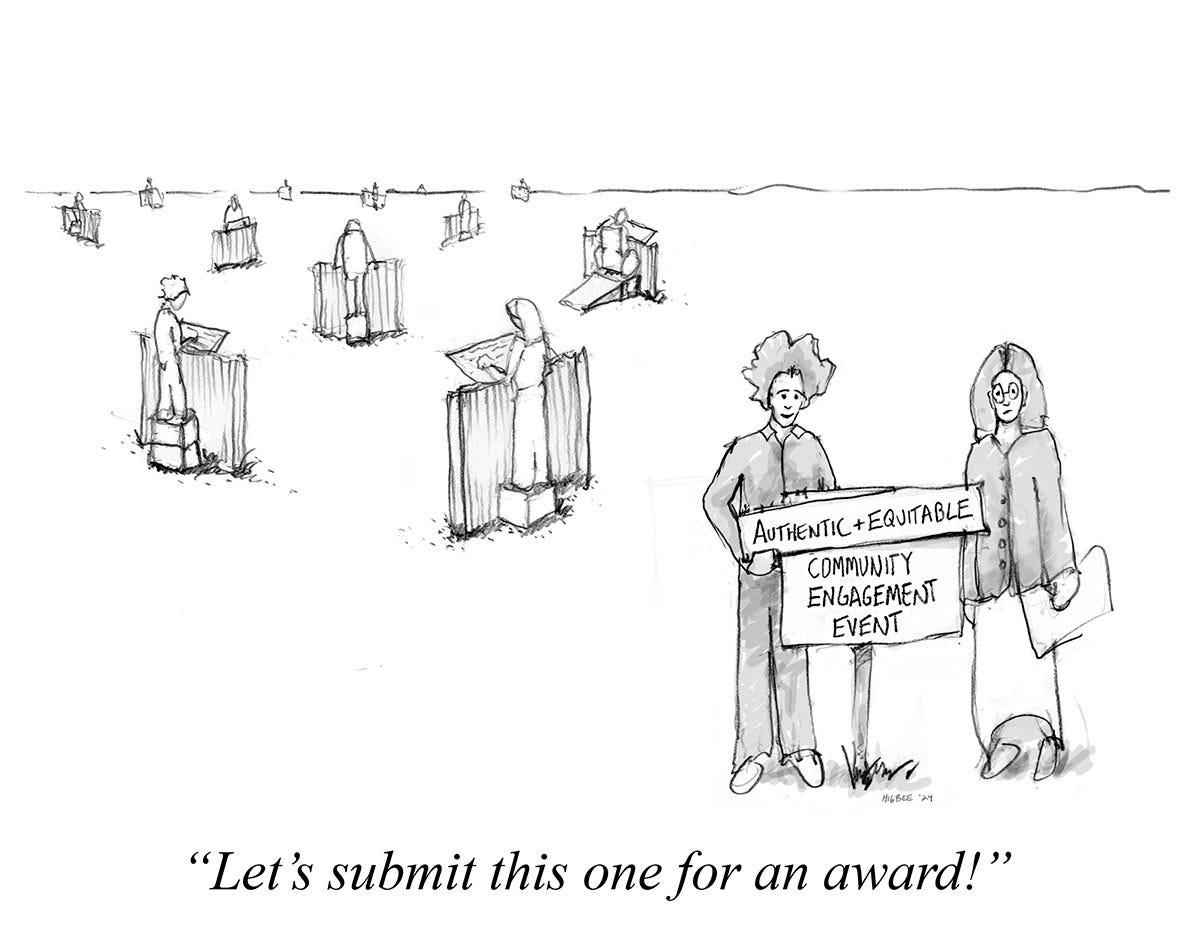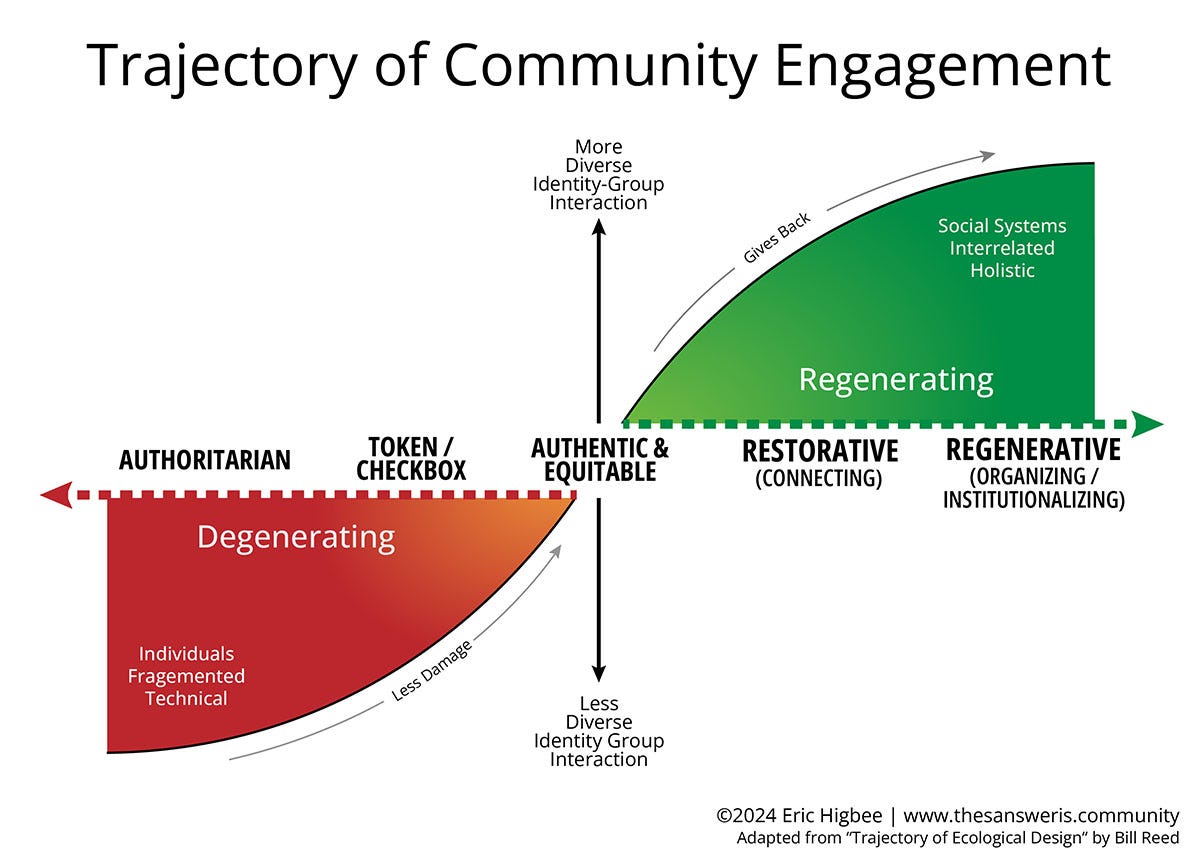Beyond Equitable and Authentic Engagement, Part 2
Three reasons authentic and equitable engagement is just one point on a trajectory of social renewal. (Estimated Reading Time: 5 minutes)
Earlier this year, I proposed a framework for community engagement inspired by a similar one for ecological design by Bill Reed. Bill’s framework illustrates how architecture, design, and engineering are moving past “sustainability” to focus instead on regenerative systems-based approaches. My community engagement version looks like this:
You will see the chart places “authentic and equitable” engagement in the middle, equivalent to “sustainable” in the ecological design version.
Authentic and equitable engagement is garnering all the attention these days. It seems like just about every conference presentation, request for qualifications, and award associated with community engagement is burnishing these bona-fides.
And, yes, this work is important. Community engagement in design, planning, and policy has a long historical record of harming or excluding many communities. That’s the red zone (“degenerating”) on the above graphic. Jettisoning these negative outcomes is critical as we strive to address generations of racial discrimination and injustice.
But authentic and equitable engagement — or at least how I see it often labeled, practiced and celebrated — falls short of the restorative and regenerative outcomes that we urgently need in our time of social fragmentation. That’s the work on the green side of the chart.
Authentic and equitable is not the finish line, but one point on the trajectory of social renewal.
Let’s take a closer look at some challenges of authentic and equitable engagement.
1. It’s often “Putting A Bird On It.”
In one of their most memorable Portlandia sketches, Fred Armisten and Carrie Brownstone enter an antiques shop and turn objects “cool” by putting a bird silhouette sticker on them. “Putting a Bird On It” is a searing and hilarious critique of hipster culture.
Ever since I first saw it, I find myself applying the “put a bird on it” catchphrase to other situations. For example, “Putting a salmon on it” is the equivalent for thoughtless environmental themed art in the Pacific Northwest.
I see authentic and equitable community engagement trending into this stickering territory. After Black Lives Matter shifted our cultural awareness, no-one wanted to be caught looking like they weren’t addressing racial and social justice. The authentic and equitable label started getting stuck on all the items in our engagement portfolio shop.
Yet when I dig a little deeper, it’s often not clear how a lot of authentic and equitable labeled engagement projects are different than business as usual. And most certainly aren’t shifting the underlying systems of power and privilege that underpin systemic inequities.
Maybe folks are just starting with their aspirations, and are figuring it out as they go. And that’s okay — we need to start somewhere.
But we should also be careful about how we label things. Authenticity and equity have real value. Without rigor and care in applying these concepts, we risk delegating them to the dustbin of meaningless terms.
2. It’s typically needs based.
The typical authentic and equitable community engagement process looks like something this:
Find a historically under-served community.
Conduct community engagement that “authentically” listens to the community to figure out their needs. Maybe work with a community-based organization.
Create a design, plan, or policy that addresses these needs.
This is what I’ve seen in just about every presentation, certification, or award that puts the forward its authentic and equity credentials.
Again, I don’t want to discount the importance of this work, especially when so much of practice has historically furthered unjust agendas of those with power and capital.
But I’m conditioned to be skeptical towards needs-based approaches.
I owe this to my familiarity with Asset Based Community Development (ABCD). ABCD discourages addressing social problems by defining people by their deficiencies. Instead, an asset-based approach builds upon the gifts and strengths within a community.
In the words of Cormac Russell, ABCD moves “from what’s wrong, to what’s strong.”
Needs-based approaches inadvertently do harm by perpetuating technocratic systems that view citizens as clients. An asset-based approach, on the other hand, strengthens a community’s social fabric by fostering social relationships and supporting community-building organizations. This is the foundation for social renewal and, yes, lasting equitable outcomes.
Such asset-based additionality is typically outside of the needs-based framing of authentic/equitable engagement. This is partly because most engagement processes are defined by the start and finish lines of design or planning projects. When the project is done, we walk away.
…most engagement processes are defined by the start and finish lines of design or planning projects. When the project is done, we walk away.
Who is responsible for the deeper, longer, relational work that transcends project-based engagement? As discussed in this previous post, there is a critical gap in stewardship from local governments and private practice. Let’s step into it.
3. It obfuscates addressing other urgent social ailments.
Racism, inequity, injustice are really important issues that demand our immediate attention.
But we are also facing other multi-faceted social crises. Loneliness. Disconnection. Polarization. Atomization. We can collectively call this “social fragmentation.”
Social fragmentation affects people of all races, colors, and ethnicities. In fact, social fragmentation is greater among lower socio-economic groups, with cascading negative impacts on health and livelihood.
Social fragmentation is upstream of most of our social challenges. As we become atomized and uprooted, we are less likely to trust or care for those who are different than us. And fragmented disadvantaged communities are less likely to have the power and efficacy to make the changes they need.
As we become atomized and uprooted, we are less likely to trust or care for those who are different than us.
We cannot fix systemic inequity and racism without also working to create connected and tolerant communities where people with different beliefs or identities can co-exist.
This requires a focus on social cohesion and pluralism. A focus on restoring and regenerating an inclusive civic life. It entails bridging identity groups and creating new shared identities rooted in place.
Place-based community engagement has incredible potential to knock this out of the ballpark.
But the spotlight on authentic and equitable outcomes is fueling an unfortunate myopia in the face of our alarmingly fragmented social condition. It’s creating a false ceiling on what we can achieve when working with communities in design, planning and policy.
The spotlight on authentic and equitable outcomes is fueling an unfortunate myopia in the face of our alarmingly fragmented social condition. It’s creating a false ceiling on what we can achieve when working with communities in design, planning and policy.
In fact, there can be dangerous current running this work: that the more we draw hard lines around our ascriptive racial and ethnic identities in the service of equity, we risk furthering fragmenting ourselves into disparate identity groups.
This is tricky sledding. But the good news is that we can be authentic and equitable AND also combat disconnection, polarization and intolerance. They can co-arise along our trajectory of social renewal.
Just as we are looking beyond sustainability in the quest for a better built environment, we need to look beyond authenticity and equity to better our civic environment.
DO YOU HAVE A STORY TO SHARE?
Do you have a great example of how a community engagement process helped a community restitch its social fabric, or go from “Us vs Them” to “We.” Or an example of how it went off the rails? I’m collecting stories, and I’d love to talk to you. Please reach out.
WHAT ELSE I’M READING
“Recipes for Social Connection” by the Office of the U.S. Surgeon General
On the heals of his "Our Epidemic of Loneliness and Isolation” advisory, Surgeon General's Vivek Murthy is at it again. “Recipes for Social Connection” is a How-To booklet for using food as a tool for social connection. How great that this is coming from the federal level? More please!
“The Movement to Bring Americans Together Sees an Opportunity. Do Funders?” in the Chronicle of Philanthropy
Responding to the recent election, “The Movement to Bring Americans Together Sees an Opportunity. Do Funders?” surveys the landscape of initiatives and organizations trying to bring together a divided America and strengthen community bonds. If you are involved in philanthropy, articles like these in the Chronicle’s “The Commons” is a great place to track the latest and greatest in bridging work.





Eric hi! Thrilled to learn of your newsletter. It's BANG ON with my own thinking and practice in the realm of community media and participatory journalism. I'd love to meet up virtually and geek out sometime if you are game. In the meantime, here's a link to a case study i wrote that makes a similar call to moving towards regenerative engagement (note: it's a long read, just check out the intro!) https://airtable.com/appaLwBurv20Db9Gl/shr9Tf5npADPNF96P